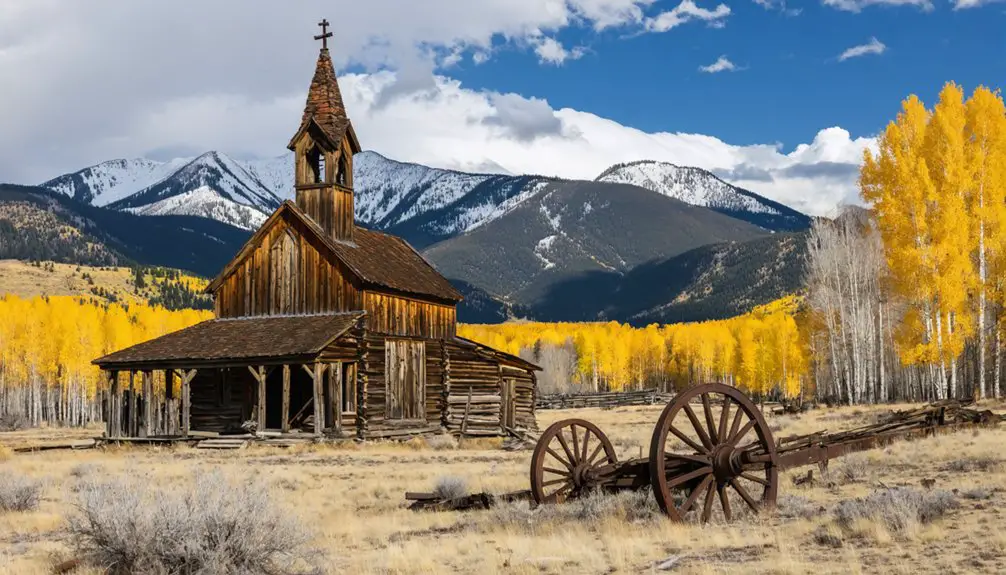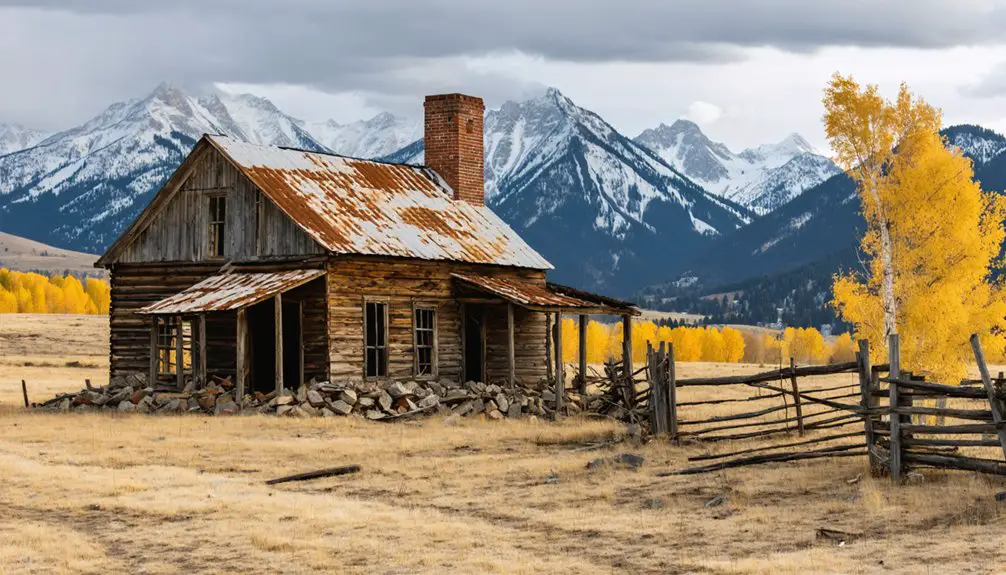You’ll find Mountain Dell’s ghost town legacy in Utah Territory, where it emerged as a pioneering settlement in the early 1860s. Joel H. Johnson established the first sawmill in 1861, attracting settlers who cultivated 58 acres of crops and built a thriving religious community. Despite its importance as a way station, the town faced devastating floods and agricultural challenges. While Mountain Dell Reservoir now covers historic structures, the settlement’s pioneering spirit echoes through Utah’s cultural heritage.
Key Takeaways
- Mountain Dell was established in 1861 as a pioneer settlement in Utah Territory, beginning with Joel H. Johnson’s sawmill near North Creek.
- Agricultural challenges, including limited arable land of only 58 acres and persistent flooding, contributed to the settlement’s eventual abandonment.
- The settlement faced major setbacks in 1866 due to Indian troubles, causing temporary abandonment before final desertion decades later.
- The community’s remnants now lie beneath Mountain Dell Reservoir, which was constructed between 1916-1917 for water management.
- The ghost town’s legacy lives on through its role as a historic hub for the Pony Express, Overland Stage, and Mormon pioneers.
The Birth of Mountain Dell Settlement
As settlers pushed deeper into Utah Territory during the early 1860s, Mountain Dell emerged as a promising settlement nestled in a basin along North Creek, roughly 4-5 miles north of present-day Virgin, Utah.
The settlement origins can be traced to Joel H. Johnson, who built a sawmill along North Creek in 1861, establishing the community’s first major piece of early infrastructure. Several pioneer families joined the settlement in 1863, helping to establish a more permanent community.
You’ll find that before it became known as Mountain Dell, the area was called Big Creek Canyon or Hanks Canyon. The settlement’s name changed to Mountain Dell in 1869 when Ephraim K. Hanks influenced the renaming.
The settlement’s strategic location northeast of Virgin, towards the Kolob Plateau, offered fertile ground for farming, though the terrain and flooding posed challenges.
Early Pioneers and Community Development
You’ll find Joel H. Johnson’s sawmill operations marked the first significant industrial development in Mountain Dell when he established the facility along North Creek in 1861.
The community’s religious organization took shape two years later with the formation of a branch of The Church of Jesus Christ of Latter-day Saints, where Johnson served as the first presiding elder until 1869. The way station site became a crucial stop for travelers and mail carriers heading east and west.
These two institutions – the sawmill supporting the area’s economic foundation and the church branch fostering social cohesion – became central pillars of Mountain Dell’s early pioneer life. By 1888, the growing settlement had established a school district in Mt. Dell to serve the educational needs of pioneer families.
Sawmill Operations Begin 1861
The establishment of Mountain Dell’s first sawmill in 1861 marked a pivotal moment in the region’s development. Joel H. Johnson, with help from millwright Brother Wilson, chose a prime location along North Creek, about four miles north of Virgin, Utah. Their sawmill technology utilized the creek’s natural water power to process local timber. Patrick Carroll and his family later followed a similar path when they built a sawmill in Heber Valley, fostering local development.
Community cooperation proved essential as pioneer families joined forces to build and operate the mill. You’ll find that the Johnson family took a central role, but shares in the operation were distributed among participating households. The mill faced a significant setback when Brother Snow criticized the sawmill project in December 1866.
The mill’s strategic position attracted more settlers, leading to the creation of cooperative stock associations. By late 1863, you could see a small town taking shape about one and a half miles downstream from the mill, where residents combined lumber processing with farming and livestock activities.
Church Branch Formed 1863
When pioneering families settled Mountain Dell in 1863, they quickly established a branch of the Church of Jesus Christ of Latter-day Saints under Joel H. Johnson. The branch organization became official in 1865 with approximately 40 members, serving as the community’s spiritual and social foundation.
Leadership succession followed a stable pattern over the next four decades. After Johnson’s presidency ended in 1869, the branch was led by Owen Isom, followed by Jorgen C. Petersen, William Isom, and Samuel Isom. The branch maintained detailed geographical data records of the settlements and surrounding territories.
These leaders coordinated not only religious matters but also community resources and defense against regional threats. The branch’s influence extended beyond spiritual guidance, helping foster pioneer cohesion and agricultural development. The community faced significant challenges when natural flooding destroyed farmlands in December 1861, leading many settlers to seek safer locations for their agricultural pursuits.
Agricultural Life Along North Creek
Despite challenging environmental conditions, Mountain Dell settlers carved out a modest agricultural existence beginning in 1863-1864, cultivating approximately 58 acres of crops including wheat, corn, cane, and cotton.
You’d have found crop diversity flourishing near the sawmill, where Joel Johnson established orchards and vineyards alongside the grain fields. The waterway now known as Parleys Creek, originally called Obit-Ko-Ke-Che Creek, flowed from the Wasatch Mountains and provided essential irrigation. Irrigation techniques relied heavily on Mountain Dell Creek and nearby water sources, though annual flooding often damaged soil fertility.
Local farmers maintained fenced pastures for livestock, with barns and corrals supporting both resident and travelers’ animals. The prominent sandstone station house served as a vital waypoint for weary travelers and their livestock seeking rest.
The settlement’s agricultural aspirations faced serious setbacks from Indian troubles in 1866, causing temporary abandonment. When settlers returned by 1869, they continued working the limited arable land, though farming remained constrained by the rugged terrain and unpredictable water supply.
Religious and Social Activities
Establishing a spiritual foundation for Mountain Dell’s pioneer community, the Church of Jesus Christ of Latter-day Saints organized a local branch in 1863 under Joel H. Johnson’s leadership.
Over the next four decades, religious gatherings became the heart of social life, strengthening community cohesion under the guidance of subsequent leaders Owen Isom, Jorgen C. Petersen, William Isom, and Samuel Isom.
You’ll find that the settlement’s social fabric was tightly woven through church events, family connections, and cooperative labor at local sawmills and orchards.
While facing challenges from Indian conflicts in 1866 and persistent flooding, the community maintained its religious identity until 1901.
After the branch’s dissolution, members joined the Virgin Ward, marking the end of Mountain Dell’s independent religious organization but preserving their spiritual connections within the broader region.
Geographic Challenges and Natural Hazards

Mountain Dell’s settlers faced persistent flooding from North Creek that repeatedly damaged their precious farmland, ultimately contributing to the settlement’s abandonment.
You’ll find that the limited arable land, totaling only 58 acres by 1866, severely restricted the community’s agricultural potential.
The combination of seasonal floods and scarce farmland created insurmountable challenges for the settlers, who couldn’t sustain their agricultural livelihood in this narrow valley setting.
Flooding Impact on Settlement
Three major flood events in Mountain Dell’s history highlight the settlement’s vulnerability to water-related hazards.
You’ll find the most devastating flood occurred in 1983, when Mountain Dell Reservoir reached capacity during unprecedented snowmelt and rainfall. Floodwaters reached 305 cubic feet per second, forcing emergency releases of 300 cubic feet per second to prevent dam failure.
The flooding consequences reshaped the region’s landscape and infrastructure. You can trace settlement abandonment to these recurring water challenges, particularly after the 1951-52 and 1983 events.
When streams overran their banks, they damaged nearby neighborhoods and overwhelmed urban infrastructure. The area’s position at the base of Big Mountain, combined with its proximity to Emigration Canyon, made it especially susceptible to these destructive hydrological events.
Limited Arable Land Availability
Beyond the challenges of flooding, the limited availability of arable land proved a persistent obstacle for Mountain Dell’s agricultural development.
You’ll find that the area’s steep mountainous terrain and rocky soil conditions severely restricted farming potential. The scarcity of prime farmland forced settlers to contend with poor soil quality and fragmented parcels unsuitable for large-scale cultivation.
The region’s agricultural limitations extended beyond soil issues.
You’re looking at an area where water scarcity complicated irrigation efforts, while high-altitude conditions shortened growing seasons. Natural hazards, including landslides and wind erosion, further degraded the usable farmland.
The combination of small, irregularly shaped plots and challenging topography meant you couldn’t effectively mechanize farming operations, ultimately contributing to Mountain Dell’s economic struggles.
The Rise and Fall of a Frontier Town
During the early 1860s, a small frontier settlement emerged along North Creek in Washington County, Utah, marking the beginning of Mountain Dell’s brief but notable existence.
You’ll find pioneer struggles evident in the community’s story, from Joel H. Johnson’s establishment of a sawmill in 1861 to the settlers’ determined cultivation of orchards and crops on limited terrain.
Despite showing remarkable community resilience through organized religious leadership and diverse agricultural ventures, Mountain Dell faced mounting challenges. The settlement weathered Indian conflicts in 1866, forcing temporary abandonment, while persistent flooding eroded precious farmland.
Legacy and Historical Significance

While Mountain Dell‘s days as a frontier settlement came to an end, its impact on Utah’s development proved far-reaching and enduring.
You’ll find its cultural heritage woven into the fabric of early Utah through pioneering achievements in water infrastructure and essential transportation routes. The area’s strategic location made it a significant hub for the Pony Express, Overland Stage, and Mormon pioneers moving westward.
The site’s most lasting contribution came through Mountain Dell Reservoir, constructed between 1916-1917, which transformed the arid canyon into a sustainable water source.
Though historic structures like Little Dell Station now rest beneath reservoir waters, the area’s significance lives on through its revolutionary water management technology and its role in establishing the transportation networks that shaped Utah’s early development.
Distinguishing Two Mountain Dells
Two distinct locations in Utah share variations of the “Mountain Dell” name, leading to frequent confusion among historians and visitors.
The Mountain Dell you’ll find in Washington County sits about 5 miles up North Creek, northeast of Virgin near the Kolob Plateau. Don’t confuse it with Delle in Tooele County, which served as a railroad village west of Salt Lake City.
The geographic distinctions are clear: Mountain Dell was an 1860s agricultural settlement in southern Utah, while Delle emerged in 1880 as a railroad stop along the I-80 corridor.
You’ll find their histories equally distinct – Mountain Dell focused on farming and milling operations under Joel Johnson’s leadership, while Delle’s story centers on its role supporting steam engines with water and maintenance facilities.
Frequently Asked Questions
Are There Any Remaining Structures or Ruins Visible at Mountain Dell Today?
Like weathered bones of the past, you’ll find few remaining structures at Mountain Dell today. Some faint ruins are visible, but they’re mostly obscured by overgrowth and natural decay.
What Was the Peak Population of Mountain Dell During Its Heyday?
While exact records don’t exist, you’ll find that population growth likely peaked under 200 residents during the 1860s-1890s, with economic factors like agriculture and sawmilling supporting a small rural community.
Did Native American Tribes Interact With Mountain Dell Settlers?
Like an ancient social network, you’ll find tribal relations centered on trade at Mountain Dell’s trading post, where cultural exchange occurred between Native American tribes and settlers through the 1850s-60s.
What Happened to the Original Sawmill Equipment After the Town’s Abandonment?
You’ll find no confirmed records of the sawmill relics – likely they were either salvaged by settlers for reuse elsewhere, deteriorated naturally from flooding, or were taken during equipment preservation efforts.
Were There Any Notable Crimes or Conflicts in Mountain Dell’s History?
Like a calm mountain lake, you won’t find many crime incidents in the records, but there were significant historical conflicts with Native Americans that forced settlers to abandon Mountain Dell in 1866.
References
- https://wchsutah.org/towns/mountain-dell.php
- https://onlineutah.us/mountaindell_history.shtml
- https://utahstories.com/2024/11/mountain-dells-legacy-how-utahs-pioneers-shaped-our-water-future/
- https://www.familysearch.org/en/wiki/Utah_Ghost_Towns
- https://usgenwebsites.org/UTWashington/towns/millvill.html
- http://wiki.hanksplace.net/index.php/Mountain_Dell_&_Pony_Express
- https://www.plaincityutah.gov/history/pages/history-daughters-utah-pioneers-plain-city-camp
- https://doctrineandcovenantscentral.org/history/joel-hills-johnson-journal-covering-the-period-from-march-1861-to-june-1882/
- https://www.nps.gov/parkhistory/online_books/poex/hrs/hrs6b.htm
- https://hebervalleyheritage.com/patrick-carroll-and-margaret-euphemia-robinson-a-heber-fort-family/



